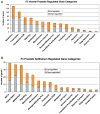Transgenerational effects of the endocrine disruptor vinclozolin on the prostate transcriptome and adult onset disease
- PMID: 18220299
- PMCID: PMC5940006
- DOI: 10.1002/pros.20724
Transgenerational effects of the endocrine disruptor vinclozolin on the prostate transcriptome and adult onset disease
Abstract
Purpose: The ability of an endocrine disruptor exposure during gonadal sex determination to promote a transgenerational prostate disease phenotype was investigated in the current study.
Methods: Exposure of an F0 gestating female rat to the endocrine disruptor vinclozolin during F1 embryo gonadal sex determination promoted a transgenerational adult onset prostate disease phenotype. The prostate disease phenotype and physiological parameters were determined for males from F1 to F4 generations and the prostate transcriptome was assessed in the F3 generation.
Results: Although the prostate in prepubertal animals develops normally, abnormalities involving epithelial cell atrophy, glandular dysgenesis, prostatitis, and hyperplasia of the ventral prostate develop in older animals. The ventral prostate phenotype was transmitted for four generations (F1-F4). Analysis of the ventral prostate transcriptome demonstrated 954 genes had significantly altered expression between control and vinclozolin F3 generation animals. Analysis of isolated ventral prostate epithelial cells identified 259 genes with significantly altered expression between control and vinclozolin F3 generation animals. Characterization of regulated genes demonstrated several cellular pathways were influenced, including calcium and WNT. A number of genes identified have been shown to be associated with prostate disease and cancer, including beta-microseminoprotein (Msp) and tumor necrosis factor receptor superfamily 6 (Fadd).
Conclusions: The ability of an endocrine disruptor to promote transgenerational prostate abnormalities appears to involve an epigenetic transgenerational alteration in the prostate transcriptome and male germ-line. Potential epigenetic transgenerational alteration of prostate gene expression by environmental compounds may be important to consider in the etiology of adult onset prostate disease.
Conflict of interest statement
The authors declare that they have no competing financial interests.
Figures








References
-
- Stoll C, Alembik Y, Dott B. Limb reduction defects in the first generation and deafness in the second generation of intrauterine exposed fetuses to diethylstilbestrol. Ann Genet. 2003;46:459–465. - PubMed
-
- Zambrano E, Martinez-Samayoa PM, Bautista CJ, Deas M, Guillen L, Rodriguez-Gonzalez GL, Guzman C, Larrea F, Nathanielsz PW. Sex differences in transgenerational alterations of growth and metabolism in progeny (F2) of female offspring (F1) of rats fed a low protein diet during pregnancy and lactation. J Physiol. 2005;566:225–236. - PMC - PubMed
-
- Gluckman PD, Hanson MA. Developmental origins of disease paradigm: A mechanistic and evolutionary perspective. Pediatr Res. 2004;56:311–317. - PubMed
Publication types
MeSH terms
Substances
Grants and funding
LinkOut - more resources
Full Text Sources
Medical
Molecular Biology Databases
Research Materials
Miscellaneous

